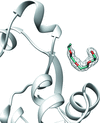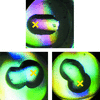issue contents
March 2017 issue
Protein-ligand complexes: understanding biological chemistry (Part 2)
Proceedings of the CCP4 Study Weekend edited by Charles Ballard, Judit Debreczeni and Paul Emsley

Cover illustration: Coot representations of ligand CQ8 in the PDB entry 4zzn.
research papers
Open  access
access
 access
accessThe use of the protein–ligand interaction energy as an additional parameter for the automated identification of crystallographic ligands and its applicability to structure validation are described.
Open  access
access
 access
accessThe current tools of Coot for ligand validation and comparison in are presented. The user-selected ligand is assessed by ligand-distortion and map-correlation metrics, and compared with those of ligands of the wwPDB to create a percentile rank.
Open  access
access
 access
accessThe potential causes of the misinterpretation of peptide density in a significant number of protein–peptide complex structures are analyzed, together with suggestions for good practice and specific education aimed at minimizing overinterpretation and mistakes in protein–peptide complex structure models.
Open  access
access
 access
accessThe metal-site validation tool CheckMyMetal is described, with examples to follow.
Open  access
access
 access
accessA guide to how the Cambridge Structural Database can be used to aid macromolecular crystallography.
Open  access
access
 access
accessSmall-molecule crystal structures are of tremendous value in understanding protein–ligand complexes, both individually and as a collection.
Open  access
access
 access
accessA high-throughput method is described for crystal soaking using acoustic droplet ejection, and its effectiveness is demonstrated.
Open  access
access
 access
accessThe importance of modelling the superpositions of ligand-bound and unbound states that commonly occur in crystallographic data sets is emphasized and demonstrated. The generation of an ensemble that models not only the state of interest is important for the high-quality refinement of low-occupancy ligands, as well as to explain the observed density more completely.
Open  access
access
 access
accessXChemExplorer is a graphical workflow and data-management tool for the parallel determination of protein–ligand complexes. Its implementation, usage and application are described here.
Open  access
access
 access
accessThe background to and development of WONKA and OOMMPPAA, tools for structure-based drug design, are described.


 journal menu
journal menu

























